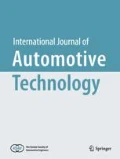Abstract
The Adaptive cruise control (ACC) systems have been actively studied for the safety enhancement and commercialized for the last five decades. The ACC has been designed not only speed and headway distance controller, but also transition maneuver. In this study, an integrated control algorithm for the ACC is proposed to maintain the speed and the headway distance simultaneously without the transitional strategy. The proposed control algorithm also adjusts the set speed depending on the curvature of the road in coordination with the Lane Keeping (LK) system. The controller is designed based on the constant acceleration model for the real time performance. The proposed algorithm is validated in simulations first and the experimental verification is performed.
Similar content being viewed by others
References
Asadi, B. and Vahidi, A. (2011). Predictive cruise control: Utilizing upcoming traffic signal information for improving fuel economy and reducing trip time. IEEE Trans. Control Systems Technology19, 3, 707–714.
Bageshwar, V. L., Garrard, W. L. and Rajamani, R. (2004). Model predictive control of transitional maneuvers for adaptive cruise control vehicles. IEEE Trans. Vehicular Technology53, 5, 1573–1585.
Bichi, M., Ripaccioli, G., Di Cairano, S., Bernardini, D., Bemporad, A. and Kolmanovsky, I. V. (2010). Stochastic model predictive control with driver behavior learning for improved powertrain control. Proc. 49th IEEE Conf. Decision and Control (CDC), Atlanta, Georgia, USA.
Dang, R., Wang, J., Li, S. E. and Li, K. (2015). Coordinated adaptive cruise control system with lane-change assistance. IEEE Trans. Intelligent Transportation Systems16, 5, 2373–2383.
Fancher, P. and Bareket, Z. (1994). Evaluating headway control using range versus range-rate relationships. Vehicle System Dynamics: Int. J. Vehicle Mechanics and Mobility23, 1, 575–596.
Ganji, B., Kouzani, A. Z., Khoo, S. Y. and Shams-Zahraei, M. (2014). Adaptive cruise control of a HEV using sliding mode control. Expert Systems with Applications41, 2, 607–615.
Gillespie, T. D. (1992). Fundamentals of Vehicle Dynamics. SAE International. Warrendale, Pennsylvania, USA.
Graf Plessen, M., Bernardini, D., Esen, H. and Bemporad, A. (2018). Spatial-based predictive control and geometric corridor planning for adaptive cruise control coupled with obstacle avoidance. IEEE Trans. Control Systems Technology26, 1, 38–50.
Ioannou, P. A. and Chien, C. C. (1993). Autonomous intelligent cruise control. IEEE Trans. Vehicular Technology42, 4, 657–672.
ISO (2018). Intelligent Transport Systems — Partially Automated in-Lane Driving Systems (PADS) — Performance Requirements and Test Procedures. ISO 21717:2018. https://www.iso.org/standard/71471.html
Kamal, M. A. S., Mukai, M., Murata, J. and Kawabe, T. (2013). Model predictive control of vehicles on urban roads for improved fuel economy. IEEE Trans. Control Systems Technology21, 3, 831–841.
Liang, C.-Y. and Peng, H. (1999). Optimal adaptive cruise control with guaranteed string stability. Vehicle System Dynamics: Int. J. Vehicle Mechanics and Mobility32, 4–5, 313–330.
Maciejowski, J. M. (2002). Predictive Control with Constraints. Pearson Education. London, UK.
MathWorks, Inc. (2015). Simulink User’s Guide. https://kr.mathworks.com/help/releases/R2013b/pdf_doc/simulink/slusing.pdf
Mattingley, J. and Boyd, S. (2012). CVXGEN: A code generator for embedded convex optimization. Optimization and Engineering13, 1, 1–27.
Mechanical Simulation (2015). VS Browser Reference Manual — The Graphical User Interface of CarSim.
Moser, D., Schmied, R., Waschl, H. and del Re, L. (2018). Flexible spacing adaptive cruise control using stochastic model predictive control. IEEE Trans. Control Systems Technology26, 1, 114–127.
Rajamani, R. (2011). Vehicle Dynamics and Control. Springer. Boston, Massachusetts, USA.
RC Coulter (1992). Implementation of the Pure Pursuit Path Tracking Algorithm. Carnegie-Mellon UNIV Pittsburgh PA Robotics INST. CMU-RI-TR-92-01.
van Arem, B., van Driel, C. J. G. and Visser, R. (2006). The impact of cooperative adaptive cruise control on traffic-flow characteristics. IEEE Trans. Intelligent Transportation Systems7, 4, 429–436.
van Nunen, E., Reinders, J., Semsar-Kazerooni, E. and van de Wouw, N. (2019). String stable model predictive cooperative adaptive cruise control for heterogeneous platoons. IEEE Trans. Intelligent Vehicles4, 2, 186–196.
Zhao, R. C., Wong, P. K., Xie, Z. C. and Zhao, J. (2017). Real-time weighted multi-objective model predictive controller for adaptive cruise control systems. Int. J. Automotive Technology18, 2, 279–292.
Acknowledgement
This work was supported by the Industrial Strategic Technology Development Program (10079730, Development and Evaluation of Automated Driving Systems for Motorway and City Road) funded By the Ministry of Trade, Industry & Energy (MOTIE, Korea).
Author information
Authors and Affiliations
Corresponding author
Additional information
Publisher’s Note
Springer Nature remains neutral with regard to jurisdictional claims in published maps and institutional affiliations.
Rights and permissions
About this article
Cite this article
Shin, K., Choi, J. & Huh, K. Adaptive Cruise Controller Design Without Transitional Strategy. Int.J Automot. Technol. 21, 675–683 (2020). https://doi.org/10.1007/s12239-020-0065-0
Received:
Revised:
Accepted:
Published:
Issue Date:
DOI: https://doi.org/10.1007/s12239-020-0065-0




